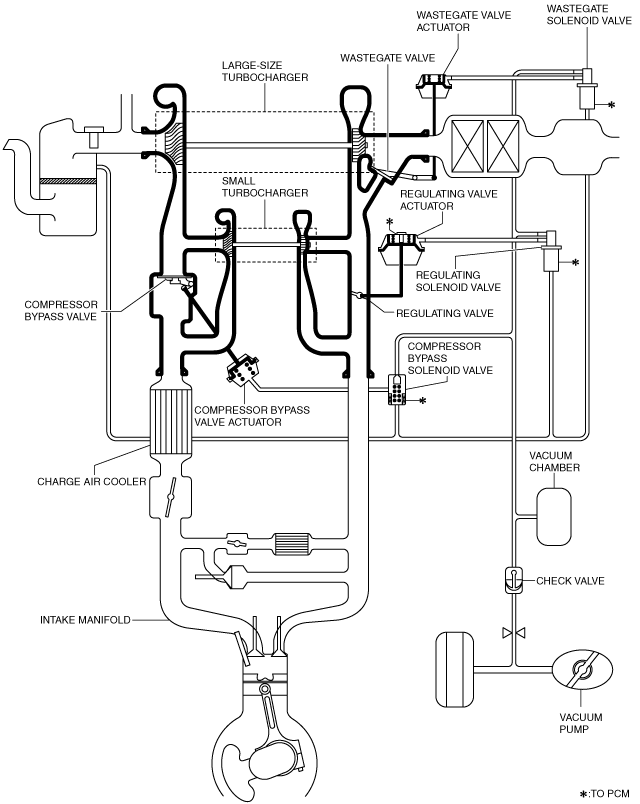AIR CHARGING SYSTEM [SKYACTIV-D 2.2]
id0113z7706400
Purpose, Outline
• By charging the intake air from the 2-stage turbocharger, the following effects are advanced.
-
― To reduce NOx generated during complete combustion, it is necessary to recirculate the exhaust gas to the combustion chamber and lower the combustion temperature. However, PM is generated by incomplete combustion due to a lack of oxygen. With the SKYACTIV-D 2.2, NOx and PM emissions are suppressed by highly efficient air charging which enables delivery of a sufficient amount of oxygen to the combustion chamber even during exhaust gas recirculation.
― By use of either the large-type turbocharger or small-type turbocharger depending on the driving conditions, high torque at low engine speed range, high response, and high output at high engine speed range is achieved.
System diagram
Structure
• The air charging system consists of the following parts.
|
Part name
|
Reference
|
|
Turbocharger
|
Large-type turbocharger
|
|
|
Small-type turbocharger
|
|
Compressor bypass valve
|
|
Compressor bypass valve actuator
|
|
Regulating valve
|
|
Regulating valve actuator
|
|
Regulating valve position sensor
|
|
Wastegate valve
|
|
Wastegate valve actuator
|
|
Compressor bypass solenoid valve
|
|
|
Regulating solenoid valve
|
|
|
Wastegate solenoid valve
|
|
|
Vacuum chamber
|
|
|
Check valve
|
|
|
Charge air cooler
|
|
Operation
• The 2-stage turbocharger control is divided between the large-type turbocharger and small-type turbocharger for control in mainly 5 regions.
1. Engine starting/partial warmup region
• For the purpose of earlier activation of the catalytio converter, air charging by the small-type turbocharger and large-type turbocharger is stopped. By stopping the air charging, the exhaust gas arrives at the catalytic converter as is with no loss of exhaust heat because it does not contact the turbine.
2. Low engine speed range
• At low engine speeds, the air charging effect by the large-type turbocharger is small because the force of the exhaust gas is small. By connecting the small-type turbocharger and large-type turbocharger in tandem and having the air charged by the large-type turbocharger further charged at the small-type turbocharger, air charging pressure is assured and high torque at the low engine speed range and high response are achieved.
3. Middle engine speed range
• In the range bordering between the low engine speed range and the high engine speed range, the regulating valve opens and closes according to the conditions. By opening and closing the valve, generation of turbocharger lag is suppressed by switching the operation of the small-type turbocharger.
4. High engine speed range
• In the high engine speed range, the small-type turbocharger is avoided because a larger amount of air is required, and only the large-type turbocharger performs air charging. By circumventing the small-type turbocharger, intake air resistance is small, and the charged air is efficiently taken in.
5. Air charging pressure excess region
• In the region where air charging pressure increases, the rise in air charging pressure is suppressed by opening and closing the wastegate valve to switch the air charging of the large-type turbocharger.
